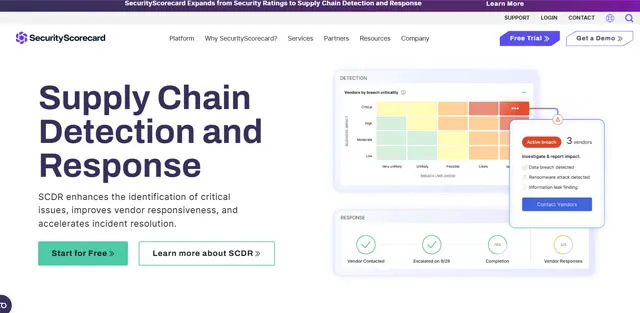SecurityScorecard
SecurityScorecard: Your A-F Guide to Proactive Cyber Risk Management

In today’s digital landscape, where cybersecurity breaches and supply chain attacks are increasingly frequent, SecurityScorecard emerges as a leading solution for evaluating and enhancing an organization’s security posture. Whether you're searching for SecurityScorecard login access, comparing SecurityScorecard competitors, or exploring SecurityScorecard pricing, this comprehensive guide covers everything you need to know to leverage the platform for effective cybersecurity risk assessment and third-party risk management.
- SecurityScorecard MAX Bolsters Supply Chain Security on CrowdStrike Marketplace
- SecurityScorecard Unveils MAX for Supply Chain Security at Gartner Summit
- China-Linked LapDogs Campaign Targets Global Networks
What is SecurityScorecard?
SecurityScorecard is a robust cybersecurity rating platform offering real-time, data-driven insights into both your organization’s and your vendors’ security postures. By continuously analyzing vulnerabilities across networks, endpoints, and applications, it assigns an intuitive A-F rating, helping stakeholders quickly assess and prioritize cyber risks. This capability makes it a valuable asset for meeting compliance standards like the NIST Cybersecurity Framework.
Key Features of SecurityScorecard
1. Comprehensive Cybersecurity Risk Evaluation
SecurityScorecard provides deep, actionable assessments of your digital environment. It identifies system weaknesses and recommends improvements to defend against threats such as advanced persistent attacks.
2. Advanced Third-Party Risk Management
Ideal for organizations managing large vendor ecosystems, SecurityScorecard enables real-time monitoring of third-party cybersecurity practices, reducing the risk of data breaches across the supply chain.
3. Automated Vendor Risk Monitoring
Its automation tools streamline vendor risk management, offering dynamic reporting and alerting to ensure compliance with internal and regulatory cybersecurity standards.
4. Compliance Alignment with NIST and Regulatory Frameworks
SecurityScorecard supports compliance with FISMA, FIPS, and other frameworks by integrating tools like security risk assessment questionnaires and templates aligned with NIST guidelines.
5. Real-Time Threat Intelligence
The platform delivers up-to-date threat intelligence, helping organizations detect indicators of compromise early and mitigate potential exploits effectively.
Why SecurityScorecard Stands Out
- Enhanced Security Posture: By clarifying and improving your security posture definition, the platform enables proactive risk management and breach prevention.
- Cost Efficiency: Although SecurityScorecard pricing is customized, early threat detection can significantly reduce the average cost of a data breach.
- Competitive Edge: Among SecurityScorecard competitors like Bitsight and RiskRecon, it’s often praised for its intuitive interface and real-time analytics, especially in community discussions such as SecurityScorecard Reddit threads.
- Industry Credibility: Platforms like SecurityScorecard Glassdoor and SecurityScorecard wiki highlight the company’s innovation, transparency, and workplace excellence.
Popular Use Cases
1. Enterprise Cyber Risk Management
Organizations utilize SecurityScorecard to perform holistic cybersecurity risk assessments, addressing threats across internal systems and external vendor networks.
2. Vendor Due Diligence
Use vendor risk assessment templates to evaluate third-party partners, minimizing vulnerabilities and exposure to third-party data breach examples.
3. Compliance and Auditing
SecurityScorecard supports cybersecurity audits and helps complete information security risk assessment questionnaires, meeting standards such as the NYDFS cybersecurity regulation.
SecurityScorecard vs Competitors: Feature Comparison
| Feature/User Aspect | SecurityScorecard | BitSight | UpGuard | Black Kite |
|---|---|---|---|---|
| SCDR Capabilities | Offers Supply Chain Detection and Response (SCDR) with AI-driven analytics (HEID) to identify and remediate zero-day vulnerabilities in 48 hours or less. Reduces third-party breaches by 75% via MAX managed service, with automated vendor collaboration. | Provides continuous monitoring and TPRM but lacks dedicated SCDR branding. Focuses on external risk ratings (250-900 scale) with analytics for supply chain cyber attacks. Less emphasis on automated response workflows. | End-to-end TPRM with vendor risk management software but no specific SCDR module. Monitors first-, third-, and fourth-party risks with data leak detection. Strong in misconfiguration checks (e.g., phishing, ransomware). | Features Bridge™ module for automated vendor outreach during major security events. Strong in OSINT and 400+ controls for risk detection but lacks end-to-end SCDR automation. |
| Primary Users | CISOs, security operations teams, risk/compliance officers, and TPRM managers in enterprises (e.g., Coca-Cola, AXA, McDonald’s). Used by 98% of Fortune 500 for enterprise cyber risk management. Ideal for large organizations needing vendor risk management and compliance with NIST2, DORA, SEC. | CISOs and risk managers in finance, healthcare, and government (e.g., Optus, Snam). Suited for organizations prioritizing detailed analytics and cyber insurance analytics. | Risk managers and compliance teams in tech, finance, and government (e.g., NASA, Accenture). Appeals to organizations needing information security risk assessment questionnaires and breach detection. | Security teams in enterprises needing OSINT-based risk detection (e.g., undisclosed major clients). Best for organizations focused on external scanning and third party data breaches. |
| Pricing Transparency | SecurityScorecard pricing is not publicly disclosed; starts at ~$16,500/year for self-assessment + 5 vendors, with additional vendors at $1,500-$2,000 each. Offers a 14-day free trial. Considered budget-friendly for scalability. | Pricing not public; reported as premium, starting at ~$30,000 for self-assessment + subsidiaries. No free tier, but offers demos. Less cost-effective for smaller businesses. | Transparent pricing starts at $1,599/month with a free plan for up to 5 vendors and a 14-day trial. Appeals to cost-conscious organizations. | Pricing not public; reported as competitive but requires sales consultation. No free tier mentioned. Focuses on cost-effectiveness for OSINT-driven TPRM. |
| Integrations | 90+ integrations with SIEM, SOAR, GRC platforms (e.g., ServiceNow, RSA Archer, AWS, Slack). Marketplace enhances SecurityScorecard login workflows for vendor risk management. Atlas module can fragment processes. | Integrates with GRC and workflow platforms (e.g., ServiceNow). Focuses on analytics over workflow extensibility, limiting SCDR automation. | Integrates with GRC, ticketing systems (e.g., ServiceNow, Jira). Strong in vendor risk assessment templates but less extensive than SecurityScorecard’s marketplace. | Robust integrations with cloud providers (AWS, Azure, Google Cloud). Bridge™ module enhances vendor outreach but relies on manual processes for full assessment cycles. |
| User-Friendliness | Intuitive interface, A-F grading system, and SecurityScorecard login portal simplify use for all technical levels. Praised for accessibility and board-ready reports. | Robust analytics but complex interface, requiring technical expertise. Less intuitive for non-experts. | Advanced configuration options but steeper learning curve. Less user-friendly for non-technical users compared to SecurityScorecard. | Comprehensive but complex platform, requiring expertise for full utilization. Less focus on simplified dashboards. |
| Unique Strengths | Leader in SCDR with MAX service for managed response. Transparent scoring via Trust Portal. Trusted by 9/10 top pharmaceutical, banking, and telecom firms. | Strong in financial risk correlation (e.g., Moody’s Analytics). Ideal for data-driven enterprises but lacks SCDR-specific focus. | Transparent pricing and breach detection expertise (e.g., Equifax, Yahoo). Strong for first-party risk but less SCDR-specific. | OSINT-driven with 3x more controls than competitors. Excels in external scanning but lacks comprehensive SCDR workflows. |
Access, Financial Insights, and User Feedback
- SecurityScorecard Login: Secure access is granted post-subscription via the official login portal. Visit the website for details.
- SecurityScorecard IPO and Revenue: For up-to-date financial data, refer to sources like SecurityScorecard wiki or reputable financial news outlets.
- SecurityScorecard Reddit: User feedback often highlights the platform’s usability, real-time threat detection, and customer support quality.
Getting Started and Exploring Community Insights
Whether you're setting up a SecurityScorecard login, browsing reviews on SecurityScorecard Glassdoor, or exploring financial updates like a potential SecurityScorecard IPO, this platform delivers reliable, actionable solutions for today’s cybersecurity demands. Learn more at the official SecurityScorecard website or explore community feedback on SecurityScorecard Reddit.
 SecurityScorecard pricing 2025: Plans, Features, and Subscription Costs Explained
SecurityScorecard pricing 2025: Plans, Features, and Subscription Costs Explained
- Price
- Contact Sales
 SecurityScorecard Reviews & Ratings: See What Users and Experts Are Saying
SecurityScorecard Reviews & Ratings: See What Users and Experts Are Saying
 SecurityScorecard FAQ: Learn How to Use It, Troubleshoot Issues, and More
SecurityScorecard FAQ: Learn How to Use It, Troubleshoot Issues, and More
SecurityScorecard provides third party risk management tools to monitor vendor security, identify vulnerabilities, and ensure compliance, protecting against supply chain attacks.
Yes, it supports the NIST cybersecurity framework, aiding compliance with FIPS and information security risk assessment requirements.
Against SecurityScorecard competitors like Bitsight, SecurityScorecard offers superior usability and real-time vendor risk management software capabilities.
SecurityScorecard offers a 14-day free trial for their Business Edition. For SecurityScorecard pricing, contact their sales team or visit the official website for customized plans.








